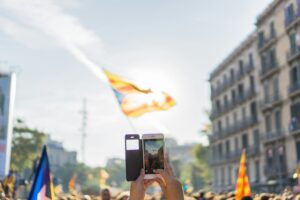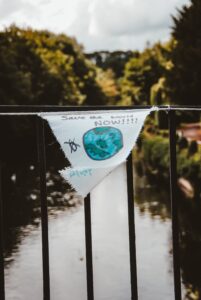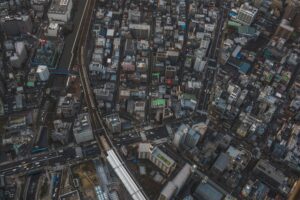
The Centre for Sociology of Democracy studies democracy in modern societies. Our projects deal with democracy from different perspectives and with different methods.
»
Recent News & Blog Posts
In their chapter for the Concise Encyclopedia of Applied Ethics in the Social Sciences, Taina Meriluoto and Eeva Luhtakallio discuss the specificities of ethical questions when studying a political topic, in particular social movements and activists in stigmatized or risky positions.
By discussing current youth’s democratic practices and introducing the concept of visual politicization, Eeva Luhtakallio, Taina Meriluoto and Carla Malafaia argue for a reconsideration of what we understand as political action and propose new methodological tools for analyzing it.
In their article, Carla Malafaia, Jenni Kettunen and Eeva Luhtakallio explore the function of bodies as tools of visibility in ritualised online-offline performances. By analysing performative protests, the authors shed light on the importance of paying attention to non-verbal levels of political action and argumentation.
In this editorial Carla Malafaia, Maria Fernandes-Jesus and Eeva Luhtakallio discuss the new diverse ways young generations have become mobilized to tackle the climate crisis and picture ways towards a common world and practices.
The Pepe the Frog Image-Meme in Hong Kong: Visual Recurrences and Gender Fluidity on the LIHKG Forum
Using a combination of a computational big data analysis and a qualitative analysis, Katrien Jakobs, Degel Cheung, Vasileios Maltezos and Cecilia Wong examine how activists used the Pepe the Frog image-meme to make statements about Hong Kong politics, gender and democracy during the 2019 Anti-Extradition Bill and Law Movement.
In her article, Carla Malafaia studies how youths manage their activism and argues that activists construct margins of resistance in their political practices by incorporating processes that interrupt adult structures while reframing educational imagination.
In their article, by augmenting Mouffe’s agonistic pluralism with Thévenot’s pragmatic sociology, Veikko Eranti and Taina Meriluoto develop both an analytical framework for a more nuanced study of urban politics as sites of democracy and a detailed conceptualization of pluralism in democracy.
In their article, Eeva Luhtakallio and Taina Meriluoto argue that a fame-based logic has become dominant in the strategies of actors in many different situations concerning political action in public. By recognizing the fame-based values informing public action with a pragmatist approach, they argue that a wider variety of action can be recognized as public action and the normative foundations that inform people’s action in public can be interrogated.
In their article, Luhtakallio, Ylä-Anttila and Lounela compare the efforts of civil society organizations to influence climate change policymaking in three countries with very different traditions of democratic decision making.
In her article, Taina Meriluoto conceptualizes selfies as reflexive practices of self-coordination, and develops an analytical framework adapted from the literature of sociology of engagements for their analysis.
Social media platforms as a tool for Elokapina’s activism
Activists participating in the environmental movement Elokapina see the sharing of images and videos in social media as a tool to tell people about daily protest activities, challenge the perceptions that people have of demonstrators and reach a wider audience for their message than would be possible through physical demonstrations. However, the personal nature of social media may also give rise to feelings of inadequacy and expose activists to strong negative attention.
The text was originally published in Finnish on December 8, 2021 in the sociological online media Ilmiö.
In connection with the news related to the results of the last municipal elections, Helsingin Sanomat highlighted the significance of Instagram as a political platform and, in October, it published an analysis of the change in the content of Prime Minister Sanna Marin’s Instagram account. Increasingly dominated by images and videos, social media has been regularly at the core of public discussion lately.
Online participation and the role of social media in societal participation have been belittled with terms such as slacktivism and clicktivism, the Finnish translation of which, “kliktivismi”, the Institute for the Languages of Finland (Kotus) chose the word of the month in May 2014. According to the definition given by Kotus, a clicktivist tweets their opinions to the world, signs a petition online and indicates their likes and unlikes in online chats. However, nowadays it is widely understood that social media offers alternative and supplementary participation methods alongside traditional political participation, which are described as individualistic, voluntary, flexible and independent.
As a rule, participation taking place in social media does not replace so-called traditional protesting, such as street activism, but often exists alongside and in relation to it. This has also been visible in the activities of the environmental movement Elokapina, which has prompted a great deal of public discussion. The Elokapina movement is part of the international Extinction Rebellion environmental movement founded in Great Britain in 2018.
Dean of the Academy of Fine Arts, Professor in Contemporary Art Research Hanna Johansson commented to Helsingin Sanomat in July that Elokapina uses “the means of art for political ends”, which has, according to Johansson, been a characteristic present in the activities of environmental movements since 1960s. Indeed, visuality is strongly present in the Extinction Rebellion movement both internationally and in Finland.
In Elokapina’s activities, visuality has been seen, for instance, in the Blood Brigade art performance consisting of silent red-clad characters who have roamed the streets of Helsinki several times, various cities’ die-in performances, in which the performers fall to the ground as if they were dead, and the logos and posters featuring the movement’s uniform graphic look.
The movement’s visuality is also strongly reflected in Elokapina’s social media content. In addition to the movement’s own posts, an integral part of Elokapina’s social media content is posts shared by other users – especially on the movement’s most popular channel, Instagram.
In this article, I look at how participants in Elokapina’s activities perceive the role of social media and the sharing of images in their own participation.

The visuality of protest is realised both in the streets and in social media
One of the developments that has taken place in social media during the last decade is the significant increase in its visual content. This so-called visual turn of social media refers to the increase in the popularity of image-oriented platforms, such as Instagram and Snapchat, and the posting and sharing of images in other services, such as Facebook or WhatsApp.
Simon Faulkner talks about the immediate and mediated aspects of protest. According to him, the aesthetics of protest encompass its immediate aspect, or space, bodies, placards and banners, for instance, and its mediated aspect, or images and videos published in social media, among other things. In Elokapina’s case, the mediated aspect of protest is constructed in social media both through Elokapina’s official accounts and through other users’ posts.
According to Nicole Doerr and Simon Teune, images produced by social movements are part of the struggle over meaning: through them, the movement can be interpreted, supported and opposed. For instance, during Elokapina’s Summer Rebellion in June 2021, many people expressed their support for the activities of the movement in their Instagram Stories, which Elokapina then re-shared actively in their own Stories. Also, before this, images published of Elokapina’s civil disobedience action organised in Kaisaniemi, Helsinki, in October 2020 spread quickly in social media and led to a public discussion about the justification of the police’s use of force.
In Elokapina’s case, a lot of attention has been paid to the movement’s strategy of using civil disobedience and less to what protests have looked like in social media, especially on the movement’s most popular channel, Instagram. In the following, I will analyse how people who have participated in Elokapina’s activities perceive the significance of social media and taking and sharing photographs with regard to their own participation. The findings are based on the interviews of 18–31-year-old Elokapina participants and the observations made by the author in Elokapina’s public events and social media platforms as part of the ongoing collection of materials for the doctoral dissertation.

Images and videos convey feelings and atmosphere
Among Elokapina activists, social media is regarded as the most important channel for providing information about the movement’s activities and inviting people to join. The activists I interviewed feel that sharing images and videos plays a significant role in street action: they are easy to spread and can show more concretely what really happened, also to those who cannot be physically present.
Especially Instagram has become a key channel, which had surprised some of the interviewees. When contemplating the reasons for this popularity, they mention factors such as Instagram’s user base, which mainly consists of young adults, the easy availability of information and the power of the images in the application to make people stop and look at them.
What, then, do people want to communicate with images? First of all, the people I interviewed take photographs to share the atmosphere and “vibes”, convey what participating in the protest is like “right now”. This may be done simply by, for example, sharing images of what it is like to camp in the middle of the street in the heart of Helsinki, as happened during the Summer Rebellion in June 2021.
One post type that appears frequently in Elokapina’s Instagram Stories is images and videos of musical performances at protests, shared by other users. They communicate the atmosphere both visually and through the soundscape and often have short texts, such as “this turned into a party”, attached to them.
Secondly, images are used to depict daily protest activities. Activists share images and videos of street drawings made with coloured chalk, flower arrangements and animal participants in the protest, for example. With their images, my interviewees also want to highlight things such as the sense of community in Elokapina’s activities.
Images and videos can also convey the feelings evoked by participating in the movement. The images taken by my interviewees often depict events from “inside the protest”, thus offering points of view that differ from news media. While news images often show more traditional demonstration imagery, such as a crowd standing in the street, during the Summer Rebellion, Elokapina’s Instagram account featured, for example, a video in which people danced freely, with the text “kattokaa kui kivaa tääl on” (“look at how much fun we’re having”).

The personal nature of social media is not without contradictions
What many of the images published in Elokapina’s social media accounts have in common is their personal nature. Many of my interviewees share their personal thoughts regarding their participation in Elokapina in social media as they feel, among other things, that it makes the movement’s activities seem closer, more relatable and more understandable. As one of the interviewees summarised: “Images highlight many personal points.”
My interviewees consider that an image published in social media has influencing power. For example, the image may show an entirely ordinary-looking person sitting in the middle of a street with a sign, as happened in the Rebellion of One protests in spring 2021. By putting their bodies in the street in this way, people want to concretely emphasise the criticality and severity of the climate crisis.

Images are also used for challenging perceptions. For example, one of the interviewees says they wanted to dispel perceptions related to the people who are involved in activism by publishing the image with their own name and face. Another interviewee wants to challenge the story of “the brave rebel” told in the public by showing the diversity of the movement’s activities and roles as for the interviewee sitting in the street is a very small part of what Elokapina actually does.
For some of the interviewees, social media appears as a motivating way to participate as it offers space for new points of view and prolongs the effects of temporary activities over a longer period of time, among other things. Although participation in the movement’s activities would be short-term or tied to a certain place, an image published in social media extends the effectiveness of the activities over a longer period of time. In addition, a wider audience can be reached in social media than in a physical demonstration.
However, this more personalised mode of communicating is not low-threshold participation for all. While some feel that being active in social media is an important and motivating way to participate and promote the movement’s goals, others associate it with feelings of inadequacy that are familiar to many activists: one could always be more active, one could always do more. For some, being active also involves the pressure to be always present in social media and the fear of becoming a centre of intensive negative attention.

Images inspire discussions and act as arguments
The significance of the strongly visual social media for Elokapina is difficult to deny. As Elokapina’s communications activist Bambi Vihavainen commented to MTV’s news earlier this year: “It is only a fraction of our audience that is concretely there witnessing the event. The majority of people see us in images and videos.” Similarly, my interviewees agree on the significance of being active in social media for the movements goals.
Indeed, images are nowadays a key element in public struggles over meaning. Images and videos can capture, save and share moments and feelings that would otherwise be at risk of remaining hidden. At the same time, images and videos shared in social media act as “evidence” and arguments for events, evoking even strong discussion – both for and against.
For Elokapina, images have already proved their power. In a short period of time, a demonstrator sitting in the street with a sign has become nearly iconic in Finnish news imagery. Moreover, images have been used forpoliticising the police’s use of force in demonstrations, which has led to a wider societal discussion on the topic. It remains to be seen how the role of images in political participation evolves and what kinds of societal discussions they will lead to in the future.
***
Images: banner image: Pyry Kantonen / Elokapina / Extinction Rebellion Finland, other images in the order of appearance: Ville Senilä / 2021 / Elokapina / Extinction Rebellion Finland, Tero Ojala / 2021 / Elokapina / Extinction Rebellion Finland, Outi Neuvonen / 2021 / Elokapina / Extinction Rebellion Finland, Pyry Kantonen / Elokapina / Extinction Rebellion Finland and Tero Ojala / 2021 / Elokapina / Extinction Rebellion Finland.









